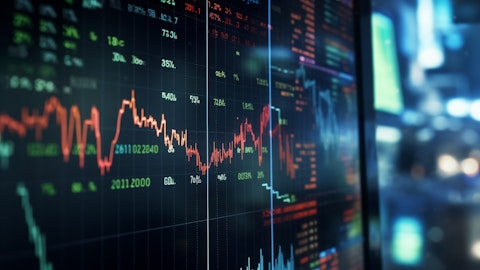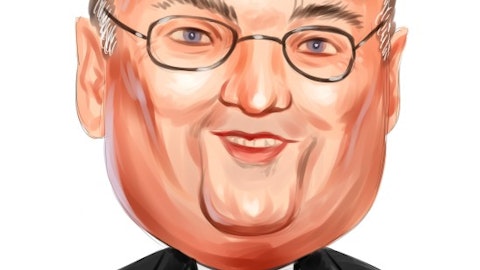As Kevin mentioned in his opening remarks, Teekay Tankers’ has reached a milestone by becoming debt free after repurchasing our eight vessels on sale leaseback arrangements during the first quarter. Based on a holistic assessment of the company’s position, including being debt-free, continuing strong operating results. Our desire to retain capital for fleet rejuvenation and a very positive market outlook, the Board has declared a special dividend of $2 per share for a combined dividend of $2.25 per share, including our regular quarterly dividend of $0.25 per share. With these dividends, Teekay Tankers has returned capital to shareholders totaling $4.25 per share since announcing our revised capital allocation plan in May of last year. I will now turn the call back to Kevin to conclude.
Kevin Mackay: Thanks, Stewart. In summary, the key drivers of the strong markets for mid-size tankers remains firmly in place. As we look ahead at both supply and demand, we are increasingly upbeat on the prospects over a multi-year period. In this environment, our high operating leverage continues to create significant value for Teekay Tankers shareholders. Our Board of Directors decision to declare a special dividend reflects our balanced approach to capital allocation while we continue to prioritize building capacity for fleet rejuvenation. The special dividend reflects our optimism about what lies ahead for our industry segment and our company. With that operator, we are now available to take questions.
Operator: Thank you. [Operator Instructions] We’ll go first to Jon Chappell with Evercore ISI. Your line is open. Please go ahead.
Jonathan Chappell: Thank you. Good morning.
Kevin Mackay: Good morning, Jon.
Jonathan Chappell: Starting with a market one, maybe for Christian. Good morning, Kevin. Maybe for Christian, Kevin, you could answer it as well. But I think the Slide 4 on the right hand side, pretty interesting. I mean, there’s a lot going on in this industry right now and a lot of geopolitical upheaval, yet when I look at the Suezmax and Aframax rates that you put in Slide 4. They’re in a super tight range for the last six months, obviously at elevated levels but within a pretty tight range. So just any commentary on why maybe some of the volatility that’s usually in this sector and one would conceptually think would be even elevated in this day and age is resulting in such stable, yet strong rates in the two asset classes where you’re primarily involved?
Christian Waldegrave: Yes. Hi, Jon. Christian here. Yes. I think that was our kind of takeaway as well in that, given everything that’s going on in the world and all the events, it is interesting to see that spot tanker rates, at least in our sectors have been quite consistent since the winter. And normally during this part of the year, we would expect rates to fall seasonally. Going into kind of the shoulder season as refineries go into maintenance. And I think what’s worked in our favor since the beginning of the year is that a couple of those events factors of what have been positive for ton-mile demand. So you’ve obviously had disruptions in the Red Sea because of the attacks on merchant shipping, which is certain tankers going on longer voyages around the Cape of Good Hope, which has affected both crude and product, it’s probably been more pronounced on the product side and the LR2s, but certainly we’ve seen some crude diverted as well.
And then with Ukrainian attacks on Russian refineries, we’ve also seen that Russian exports have stayed elevated as well. So I think there’ve been some factors there that have supported [indiscernible] during what would ordinarily be a seasonally weaker part of the year. And that probably bodes well for the second half as well because as Kevin said in his prepared remarks, we now have the Trans Mountain pipeline coming online and ramping up into the second half Q2 here. And we certainly expect bonds there to be supportive of Aframax demand to get into the second half of the year. And we should see more oil volume come online in the second half as well. So yes, it has been a positive development that rates have stayed elevated through Q2 and it gives us some confidence for the rest of the year here as well.
Jonathan Chappell: Okay. That’s helpful. Thanks, Christian. And then just for my follow-up in the interest of playing the hits. Kevin, I think the special dividends being widely applauded today, you’re down to a net cash position. So I’m just not asking you to completely show your hand, but maybe just a clarification on top from here. If you could just prioritize kind of how you think about this massive cash flow that Stewart pointed out in the coming quarters, how would you prioritize the uses of capital? Let’s call it through the rest of 2024 and through 2025?
Kevin Mackay: Yes. It’s obviously a fantastic situation to be in after the markets that we’ve had to come through over the last few years. But it’s something that as a management team and in conjunction with our Board, we’re always looking at and always trying to discuss. We do have fleet renewal to look at and although pricing today is elevated on both new builds and secondhand, there is a need for us to replenish as we sell ships. We still want to keep exposure to the spot market because of the confidence we have in the underlying fundamentals of the market. So as we roll off some of the older ships, you may see us use some of that capital to reinvest and keep our spot exposure at a high level. So some of the cash maybe used for that.
We also have to look beyond that and look to the future as to doing larger fleet rejuvenation exercises, which we’re not advocating to do now. But we are cognizant of the cyclicality of our market and keeping that powder dry for that use is important for us to be able to provide long-term value to shareholders. And then obviously we understand and fully respect that shareholders would like a yield. And in that respect, our capital allocation plan that we came up with last year, we felt was a prudent long-term orientated plan that satisfied both the rebuilding of the fleet as well as replenishing some capital back to shareholders in the meantime.
Jonathan Chappell: Okay. Yes. That’s very clear. Thank you, Kevin. Thanks, Christian
Kevin Mackay: Thanks Jon.
Operator: We’ll go next to Omar Nokta with Jefferies. Your line is open. Please go ahead.
Omar Nokta: Thank you. Hey guys. Yes, I just wanted to follow-up maybe on Jon’s question. I know it’s something that constantly comes up. But clearly now you’re in the net cash position completely debt free. So congrats obviously on that, it’s been a long time coming. But did notice, you’ve accounted for two shifts as available for sale as of the end of the quarter. So it looks like you’re going to continue to scale as you were just talking about Kevin. You got 42 tankers in the fleet. After those two there’s going to be 40 you mentioned looking to replace ships as you sell them. I guess kind of just thinking about that. If we think about the fleet sites today, say post those sales, you’ll have 40 vessels. Is there a certain critical mass or certain number that you’re comfortable wanting to stay above in order to continue to achieve these types of rates?





